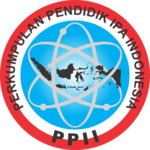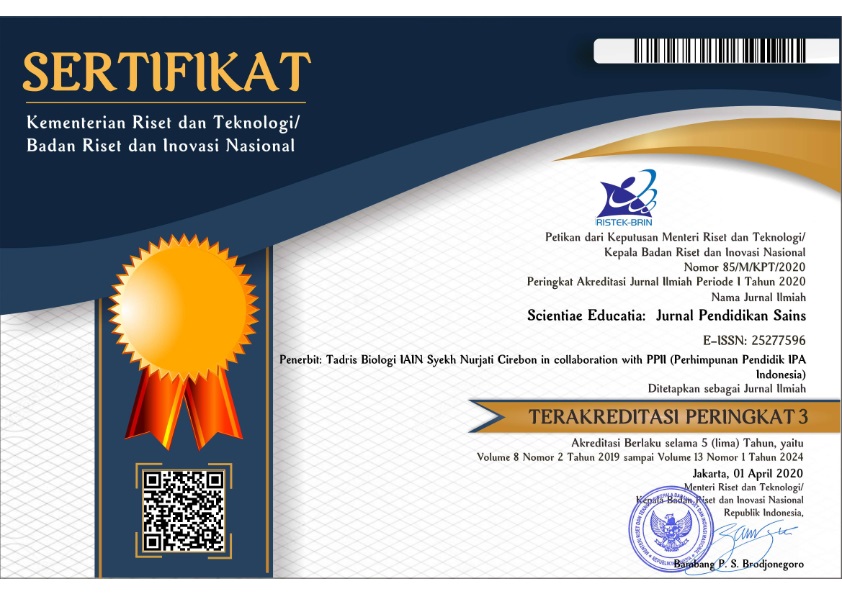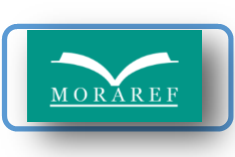KARAKTER FENOTIP KEDELAI (Glycine max (L.) Merr.) HASIL POLIPLOIDISASI DENGAN KOLKISIN
(1) Universitas Gadjah Mada
(2) Universitas Gadjah Mada
(*) Corresponding Author
Abstract
Abstract - Soybean (Glycine max (L.) Merr) is one of the most important food commodity to fulfill the protein necessity in Indonesia. Although Indonesia has many prime soybean seeds, it cannot fulfill the whole need of soybean and always rely on soybean import. This problem can be solved by increasing the quality and productivity of prime soybean seed by polyploidization with colchicine. This research aimed to study ploidy level and phenotype characters of Anjasmoro soybean which was induced by colchicine. The phenotype characters in this research were stomata size, plant height, total pod in one plant, total seed in one plant, weight of 100 seeds, flowering time, and ripening time of soybean. The ploidy level was analyzed with flow cytometry methode. The data was analyzed with one way ANOVA and Duncan test in SPSS 22 program. The result of this research showed that Anjasmoro soybean did not successfully induced by colchicine using concentration 0.01%, 0.02%, 0.025%, 0.05%, 0.075%, 0.1%, 0.15%, 0.2%, and 0.25% with duration of treatment 6, 8, 10, 12, 16, 18, and 24 hours. The treatment with colchicine concentration 0.01% and 0.02% with duration of treatment 10 hours effected the increasing of stomata size, the plant height, and the weight of 100 seeds.
Key words : Soybean, polyploidization, colchicine, phenotype
Abstrak - Kedelai (Glycine max (L.) Merr) merupakan salah satu komoditas pangan penting sebagai sumber protein nabati yang kebutuhannya selalu mengalami peningkatan di Indonesia. Meskipun saat ini Indonesia memiliki banyak varietas kedelai unggul, namun Indonesia masih belum mampu mencukupi kebutuhan kedelai nasional sehingga terus bergantung pada impor kedelai. Permasalahan ini dapat diatasi dengan meningkatkan kualitas dan produktivitas varietas kedelai unggul yang sudah ada melalui teknik poliploidisasi dengan kolkisin. Penelitian ini bertujuan untuk mengetahui derajat ploidi dan karakter fenotip pada kedelai Anjasmoro yang diinduksi dengan kolkisin. Karakter fenotip yang diamati adalah panjang dan lebar stomata, tinggi tanaman, jumlah polong per tanaman, jumlah biji per tanaman, berat 100 biji, umur berbunga, dan umur masak kedelai. Analisis derajat ploidi kedelai dilakukan dengan metode flow cytometry. Data yang diperoleh dianalisis dengan uji statistik one way ANOVA dan dilanjutkan dengan uji Duncan taraf 5% menggunakan program SPSS 22. Hasil penelitian menunjukkan bahwa kedelai Anjasmoro belum berhasil terinduksi poliploid dengan perlakuan kolkisin konsentrasi 0,01%, 0,02%, 0,025%, 0,05%, 0,075%, 0,1%, 0,15%, 0,2%, dan 0,25% dengan lama waktu perlakuan 6, 8, 10, 12, 16, 18, dan 24 jam. Perlakuan kolkisin konsentrasi 0,01% dan 0,02% dengan lama waktu perlakuan 10 jam mempengaruhi peningkatan ukuran stomata, tinggi tanaman, dan berat 100 biji kedelai Anjasmoro.
Kata kunci : Kedelai, poliploidisasi, kolkisin, fenotip
Full Text:
PDFReferences
Adisarwanto, T. (2014). Kedelai tropika produktivitas 3 ton/ha. Penebar Swadaya : Jakarta.
Adisewoyo, S. (1995). Sitogenetika. Gadjah Mada University Press : Yogyakarta.
Allum, J. F., Bringloe, D. H., & Robert, A. V. (2007). Chromosome doubling in a Rosa rugosa Thunb. hybrid by exposure of in vitro nodes to oryzalin : the effects of node length, oryzalin concentration and exposure time. Plant Cell Rep. 26 : 1977 – 1984.
BPS (Badan Pusat Statistik). (2014). Produksi kedelai indonesia. (www.bps.go.id). Diakses pada tanggal 13 Mei 2015.
Burns, G. W. (1972). The science of genetics, an introduction to heredity. Second Edition. The Macamillan Company : New York.
Burun, B., & Emiroglu, U. (2008). A comparative study on colchicine application methods in obtaining doubled haploids of tobacco (Nicotiana tabacum L.). Turk. J. Biol. 32 : 105-111.
Can, S. (2012). Polyploid organisms. Science China. Life Sciences. Vol. 55, No. 4 : 301-311.
Comai, L. (2005). The advantages and disadvantages of being polyploid. Genetics. Vol. 6 : 836-846.
Costich, D. E., Ortiz, R., Meagher, T. R., Bruederle, L. P., & Vorsa, N. (1993). Determination of ploidy level and nuclear DNA content in blueberry by flow cytometry. Theor. Appl. Genet. 86 : 1001-1006.
Daryono, B. S. (1998). Pengaruh kolkisin terhadap pembentukan sel-sel melon tetraploid. Buletin agro Industri No. 5 : 2-11.
Dnyansagar, V. R. (1992). Cytology and genetics. Tata McGraw-Hill Publishing Company : New Delhi.
Dolezel, J., & Bartos, J. (2005). Plant DNA flow cytometry and estimation of nuclear genome size. Oxford Journals Science & Mathematics. Annals of Botany. Vol. 95 : 99-110.
Essel, E., Isaac, K., Asante, & Ebenezer, L. (2015). Effect of colchicine treatment on seed germination, plant growth and yield traits of cowpea (Vigna unguiculata (L.) Walp.). Canadian Journal of Pure and Applied Sciences. Vol. 9, No. 3 : 3573-3576.
Finkelstein, Y., Aks, S. E., Hutson, J. R., Juurlink, D. N., Nguyen, P., Dubnov-Raz, G., Pollak, U., Koren, G., & Bentur, Y. (2010). Colchicine poisoning : the dark side of an ancient drug. Clin Toxicol (Phila). 48 (5).
Herman, N., Irma, M., & Dewi, I. R. (2013). Pengaruh mutagen kolkisin pada biji kacang hijau (Vigna radiata L.) terhadap jumlah kromosom dan pertumbuhan. Prosiding Seminar Nasional Biodiversitas dan Ekologi Tropika Indonesia (BioETI) Universitas Andalas.
Jaroslav, D. J. & Jan, S. G. (2007). Flowcytometry with plant cell. WILEY-VCH Verlag GmbH & Co. KgaA : Weinheim.
Limera, C., Wang, K., Xu, L., Wang, Y., Zhu, X., Feng, H., Sha, Y., Gong, Y., & Liu, L. (2016). Induction of autotetraploidy using colchicine and its identification in radish (Raphanus sativus L.). The Journal of Horticultural Science and Biotechnology. Vol. 91, No. 1 : 63-70.
Liu, G., Li, Z., & Bao, M. (2007). Colchicine induction chromosome doubling in Platanus acerifolia and its effect on plant morphology. Euphytica. 157 : 145-154.
Lucket, D. (1989). Colchicine mutagenesis in associated with substantial heritable variation in cotton. Euphytica. 42 : 177-182.
Mercy Kutty, V. C. (1983). Studies on induced tetraploid in four diverse cultivars of pea (Pisum sativum L.). Cytologia. 48(1) : 51-58.
Panteris, E., Apostolakos, P., & Galatis, B. (1993). Microtubules and morphogenesis in ordinary epidermal cells of Vigna sinensis leaves. Protoplasma. Vol. 174(3) : 91-100.
Rachmawati, D., Nasir, M., Sudjino, & Dewi, K. (2009). Bahan ajar fisiologi tumbuhan. Fakultas Biologi UGM : Yogyakarta.
Sarathum, S., Hegele, M., Tantiviwat, S., & Nanakorn, M. (2010). Effect of concentration and duration of colchicine treatment on polyploidy induction in Dendrobium scabrilingue L. Europ. J. Hort. Sci. 75 : 123-127.
Shi, L., Zhu, T., Morgante, M., Rafalski, J. A., & Keim, P. (1996). Soybean chromosome painting : a strategy for somatic cytogenetics. Journal of Heredity 87 (4) : 308-313.
Suhartina. (2005). Deskripsi varietas unggul kacang-kacangan dan umbi-umbian. Balai Penelitian Tanaman Aneka Kacang dan Umbi : Malang.
Sundov, Z., Nincevicb, Z., Definis-Gojanovicc, M., Glavina-Durdovc, M., Jukica, I., Hulinad, N., & Tonkica, A. (2005). Fatal colchicine poisoning by accidental ingestion of meadow saffron-case report. Forensic Science International. 149 : 253-256.
Tamam, M. B. (2015). Analisis variasi fenotip dan molekular kembang kertas (Zinnia elegans Jaqc.) hasil induksi kolkisina. Tesis. Tidak diterbitkan. Yogyakarta : Fakultas Biologi UGM.
Vodyanova, O. S. (1974). The effect of colchicine on the formation of autopolyploid tissues in the root meristem of Allium cepa L. and the output of polyploids. Genetika-i-selektsiya-rast-i-zhivotnykh-v-Kazakhstane : 83-87.
Wang, Z., You, R., & Chen, X. (2001). Effects of colchicine on the accumulation of vacuolar H+- pyrophosphatase and H+- ATPase in germinating Acacia mangium seeds and the recovery effects by sucrose, indole butyric acid and 6-benzyladenine. Plant Growth Regulation. Vol. 34(3) : 293-303.
Wardhani, M. & Wiendi, N. M. A. (2015). Induksi mutasi genetik melalui penggandaan kromosom kedelai (Glycine max (L.) Merr.) varietas wilis dan tanggamus dengan kolkisin secara in vitro. Prosiding Simposium dan Seminar Bersama PERAGI-PERHORTI-PERIPI-HIGI Mendukung Kedaulatan Pangan dan Energi yang Berkelanjutan.
Wiradharma, I. G. L. A. (2013). Induksi poliploid kacang tanah (Arachis hypogaea L. varkelinci) dengan kolkisin. Skripsi. Tidak diterbitkan. Yogyakarta : Fakultas Biologi UGM.
DOI: 10.24235/sc.educatia.v5i2.957
Article Metrics
Abstract view : 2099 timesPDF - 2062 times
Refbacks
- There are currently no refbacks.
Scientiae Educatia: Jurnal Pendidikan Sains indexed by:

This work is licensed under a Creative Commons Attribution 4.0 International License.
Stat Counter (Link)



1.png)












